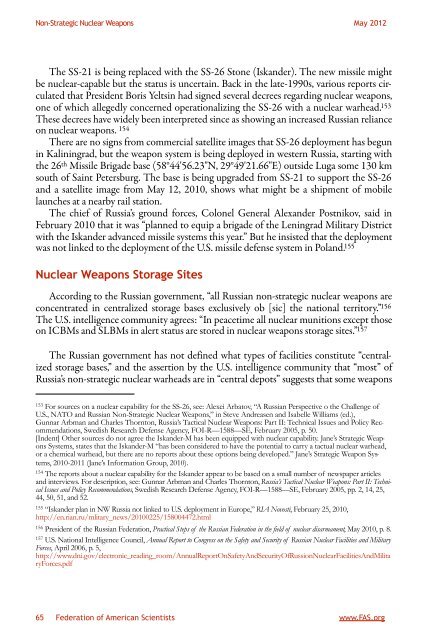Non Strategic Nuclear Weapons - Federation of American Scientists
Non Strategic Nuclear Weapons - Federation of American Scientists
Non Strategic Nuclear Weapons - Federation of American Scientists
You also want an ePaper? Increase the reach of your titles
YUMPU automatically turns print PDFs into web optimized ePapers that Google loves.
<strong>Non</strong>-<strong>Strategic</strong> <strong>Nuclear</strong> <strong>Weapons</strong> May 2012<br />
The SS-21 is being replaced with the SS-26 Stone (Iskander). The new missile might<br />
be nuclear-capable but the status is uncertain. Back in the late-1990s, various reports circulated<br />
that President Boris Yeltsin had signed several decrees regarding nuclear weapons,<br />
one <strong>of</strong> which allegedly concerned operationalizing the SS-26 with a nuclear warhead. 153<br />
These decrees have widely been interpreted since as showing an increased Russian reliance<br />
on nuclear weapons. 154<br />
There are no signs from commercial satellite images that SS-26 deployment has begun<br />
in Kaliningrad, but the weapon system is being deployed in western Russia, starting with<br />
the 26 th Missile Brigade base (58°44'56.23"N, 29°49'21.66"E) outside Luga some 130 km<br />
south <strong>of</strong> Saint Petersburg. The base is being upgraded from SS-21 to support the SS-26<br />
and a satellite image from May 12, 2010, shows what might be a shipment <strong>of</strong> mobile<br />
launches at a nearby rail station.<br />
The chief <strong>of</strong> Russia’s ground forces, Colonel General Alexander Postnikov, said in<br />
February 2010 that it was “planned to equip a brigade <strong>of</strong> the Leningrad Military District<br />
with the Iskander advanced missile systems this year.” But he insisted that the deployment<br />
was not linked to the deployment <strong>of</strong> the U.S. missile defense system in Poland. 155<br />
<strong>Nuclear</strong> <strong>Weapons</strong> Storage Sites<br />
According to the Russian government, “all Russian non-strategic nuclear weapons are<br />
concentrated in centralized storage bases exclusively ob [sic] the national territory.” 156<br />
The U.S. intelligence community agrees: “In peacetime all nuclear munitions except those<br />
on ICBMs and SLBMs in alert status are stored in nuclear weapons storage sites.” 157<br />
The Russian government has not defined what types <strong>of</strong> facilities constitute “centralized<br />
storage bases,” and the assertion by the U.S. intelligence community that “most” <strong>of</strong><br />
Russia’s non-strategic nuclear warheads are in “central depots” suggests that some weapons<br />
153 For sources on a nuclear capability for the SS-26, see: Alexei Arbatov, “A Russian Perspective o the Challenge <strong>of</strong><br />
U.S., NATO and Russian <strong>Non</strong>-<strong>Strategic</strong> <strong>Nuclear</strong> <strong>Weapons</strong>,” in Steve Andreasen and Isabelle Williams (ed.),<br />
Gunnar Arbman and Charles Thornton, Russia’s Tactical <strong>Nuclear</strong> <strong>Weapons</strong>: Part II: Technical Issues and Policy Recommendations,<br />
Swedish Research Defense Agency, FOI-R—1588—SE, February 2005, p. 50.<br />
[Indent] Other sources do not agree the Iskander-M has been equipped with nuclear capability. Jane’s <strong>Strategic</strong> <strong>Weapons</strong><br />
Systems, states that the Iskander-M “has been considered to have the potential to carry a tactual nuclear warhead,<br />
or a chemical warhead, but there are no reports about these options being developed.” Jane’s <strong>Strategic</strong> Weapon Systems,<br />
2010-2011 (Jane’s Information Group, 2010).<br />
154 The reports about a nuclear capability for the Iskander appear to be based on a small number <strong>of</strong> newspaper articles<br />
and interviews. For description, see: Gunnar Arbman and Charles Thornton, Russia’s Tactical <strong>Nuclear</strong> <strong>Weapons</strong>: Part II: Technical<br />
Issues and Policy Recommendations, Swedish Research Defense Agency, FOI-R—1588—SE, February 2005, pp. 2, 14, 25,<br />
44, 50, 51, and 52.<br />
155 “Iskander plan in NW Russia not linked to U.S. deployment in Europe,” RIA Novosti, February 25, 2010,<br />
http://en.rian.ru/mlitary_news/20100225/158004472.html<br />
156 President <strong>of</strong> the Russian <strong>Federation</strong>, Practical Steps <strong>of</strong> the Russian <strong>Federation</strong> in the field <strong>of</strong> nuclear disarmament, May 2010, p. 8.<br />
157 U.S. National Intelligence Council, Annual Report to Congress on the Safety and Security <strong>of</strong> Russian <strong>Nuclear</strong> Facilities and Military<br />
Forces, April 2006, p. 5,<br />
http://www.dni.gov/electronic_reading_room/AnnualReportOnSafetyAndSecurityOfRussion<strong>Nuclear</strong>FacilitiesAndMilita<br />
ryForces.pdf<br />
65 <strong>Federation</strong> <strong>of</strong> <strong>American</strong> <strong>Scientists</strong> www.FAS.org
















